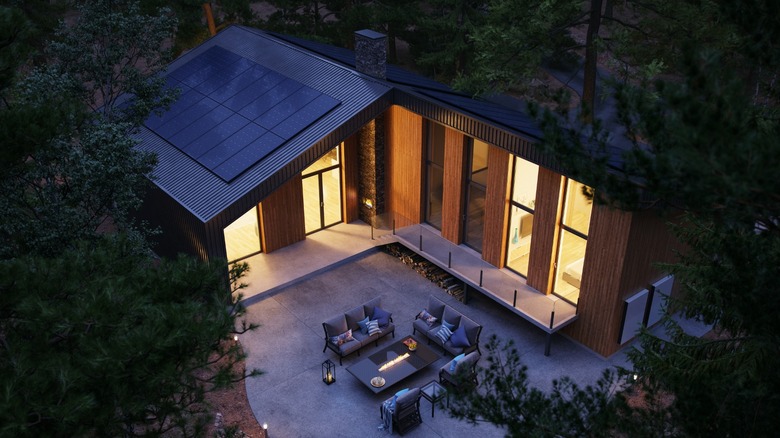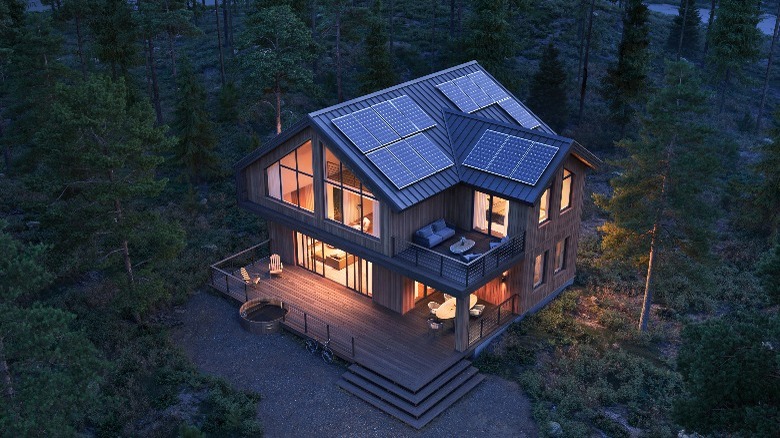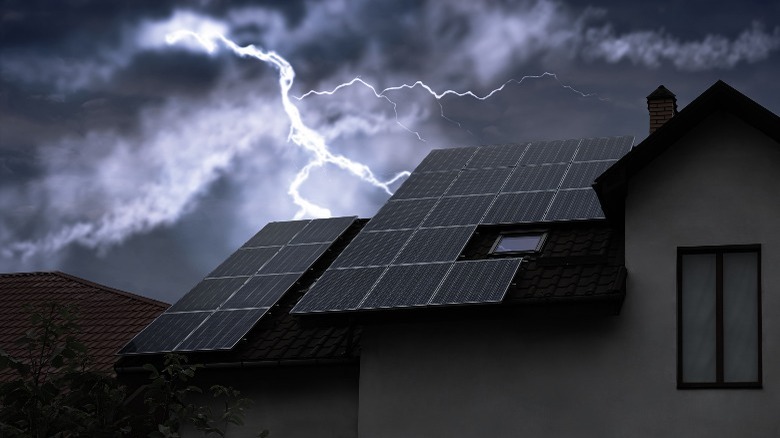Do Your Solar Panels Work At Night And When It's Cloudy?
Solar power is the cleanest and most abundant form of renewable energy, with significant consumer adoption across the U.S. in recent years. Roughly 3.2 million homes in the country have solar panels already installed, and the number is steadily growing. Q2 of 2023 showed a 30% increase in the U.S. residential solar market compared to Q2 of 2022. In total, over 27.5 million homes in the country use solar energy — including those that don't have their own solar panels and use community solar programs – with projections taking that beyond 65 million homes by 2028.
There are many benefits this form of energy offers compared to the conventional electric grid — plus a few common solar panel myths we'll discuss later. Firstly, in the U.S., the federal residential solar panel credit lets those installing solar power systems claim a 30% tax credit on costs. Furthermore, utility bills can reap savings with credit earned on bills if excess energy is generated and fed back into the grid. Alternatively, leasing a solar power system hosted on a home rooftop allows the generated electricity to be bought back at a discount. It's also possible for a property to store the energy in a battery, helping the home be less reliant on the grid in times of disruption. For those who do install solar panels, they've been shown to increase your home's value.
Do solar panels work at night?
Solar panels, as their name suggests, need sunlight to function. They consist of photovoltaic cells, featuring semiconductors that release electrons when hit by photons from sunlight — producing electricity. In other words, they don't work at night. You may wonder why moonlight, which is just reflected sunlight after all, can't power solar panels. There are several factors involved, including the energy efficiency of solar panels, which is typically between 15 and 30%. This means panels can only convert that particular percentage of solar energy into electricity.
Consider that, on average, at the top of the atmosphere, the Earth receives 1,360 watts of solar energy per square meter. Moonlight, on the other hand, works out to approximately 0.0006 watts per square meter at full moon. Acknowledging this difference, moonlight energy is close to 2.3 million times weaker than sunlight. Even if we examine only luminosity rather than energy, moonlight is still 1 million times weaker than sunlight at its brightest.
However, all this doesn't mean that you can't use solar energy at night. If you invest in solar batteries, the unconsumed excess energy that your solar panels produce during the day can be stored and used to power your house at night. The same principle applies to the scheme known as net metering, where the excess energy (or even all the energy) your solar panels produce is fed into the utility grid, offsetting your utility costs with credits.
Do solar panels work when it's cloudy?
Solar panels do work on cloudy days, because despite cloud cover — which blocks, reflects, and absorbs sunlight — some diffused sunlight still penetrates through to reach the panels. However, the reduced intensity of sunlight on cloudy days means the solar panels capture less energy. Modern systems are more efficient than earlier iterations in this regard, as panels work with a broader spectrum of light than in the past. Interestingly, rain can be helpful for solar panels as it washes away dust and dirt that accumulate over time, hampering their ability to absorb sunlight.
Snow can also limit solar panel efficiency. However, if it's a thin film of snow, the reduction will be minimal. Thick snow, however, will block sunlight and dramatically reduce efficiency — a key reason for panels to be sloped correctly so that the snow can slide off. Like rain, snow can also clean solar panels when it melts.
Cold temperatures can actually aid solar energy generation. This is due to how semiconductor-based electronics work; lower temperatures increase what's known as the band gap of the panel's materials, improving efficiency and, therefore, increasing the production of electricity. Considering all this, it's not surprising that solar panels are most efficient in cold and sunny weather.
The future of solar panels
Although adverse conditions reduce the energy solar panels might generate, to varying degrees, research and development into the popular technology is finding ways to produce electricity reliably regardless of the weather. A breakthrough for night-time use was made in 2022 by scientists at Stanford University, who added a thermoelectric generator (TEG) to the solar panel to exploit its temperature difference when cooling to the night air around it. This innovation turns solar panels into a 24-hour renewable energy resource. In fact, the TEG can also be used in reverse in the daytime, producing electricity as the panel heats up.
In 2018, working to improve the efficiency of solar panels in the rain, scientists at Soochow University in China used a triboelectric nanogenerator (TENG) to harness the kinetic energy of raindrops to produce electricity. The team placed a transparent layer featuring the TENG on top of a traditional solar panel, allowing it to utilize the motion of rain as it impacted the panel and slid off to generate electricity. Both the TEG and TENG technologies are in their infancy, however, and it will take a while for such innovations to have commercial applications.
An idea already in action at dozens of large solar panel installations around the world is robot solar panel cleaners that remove dust and dirt to increase efficiency. These autonomous machines work at night to reduce disruption to daylight solar energy capture, using cloth and air to clean, saving water in the process.



